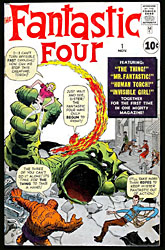Points of Articulation
First Appearance Thing Addendum
I didn't want to take over the First Appearance Thing review with a diatribe about his included reprint of Fantastic Four #1, but it's stuff worth discussing. So consider this a sidebar to the Thing review.
Today, Fantastic Four #1 is generally considered a watershed moment for comics, the birth of a new era and the revitalization of the superhero. But if you can actually shut off everything you know about the comic and just sit down and read it, it's a much different story.
Stan's story is clunky, to say the least. We get an introduction as the team is called together to face danger (in Central City, not New York - guess Marvel wouldn't adopt the real world locales until later), then we go back in time for their origin story, and then we return to the present (their present - 1961) for the briefing and the actual battle. This sort of flashback is hard to pull off successfully in more mature forms of entertainment, let alone in the comics of the '60s. Why recount the origin in the middle of the story? Well, for the dramatic reveal of the new foursome unleashing their powers for the first time, of course - except that we'd already seen it all on the cover, so the surprise was already blown. There wasn't an in-story reason to do it that way; even a throwaway line about how this was the first time they tried anything like this since the accident would have made a better segue.
On top of that, the characters are cliches. The brilliant scientist? His wholesome socialite girlfriend and her hotrodding younger brother? The tough guy? Those are stock characters from any number of B-movie plots. Even their powers had been done before, with the exception of the Thing, who was pretty much one of the classic Marvel monsters thrown on the good guys' side - in fact, one look at the other books Marvel released that month will show you just how average the large, craggy orange guy is:

And speaking of giant monsters, Marvel's stock in trade in the pre-superhero days, the back half of this story reads like a fairly run-of-the-mill monster story. Nuclear plants are disappearing all over the world, sucked down into the very earth. Surprise surprise, it's monsters doing it. The hero (or in this case, heroes) go to stop it and save humanity. The twist, if you can call it that, is that the monsters are being controlled by another old standby from the monster stories: the odd recluse who has sworn revenge on the world that spurned him.
Jack Kirby is considered the god of comic art, but a lot of his stuff hasn't really aged gracefully, especially things of this early vintage. How does one man manage to make a single drawing look both dynamic and flat? It's a mystery, but Jack succeeds. It's possible that it's the inker's fault (no inker is credited, and the actual hand is unknown to this day, but the smart money is on George Klein with a little help from Christopher Rule), but it's more likely that the problem is actually with the reprint rather than the original.
Not that everything about Kirby's art is beyond reproach. Take a look at that classic cover. Really look at it. Soak it in.
 Notice anything out of place? Rewind the scene about 30 seconds and figure out what was going on. The fact that there are still civilians in the street, and that they seem to be off-balance, tells us that the monster just now burst up through the ground - like Torch says, the Fantastic Four have only begun to fight. He means that literally. The monster hasn't been hanging out there for an hour waiting for the FF to show up. In fact, he probably came up right under Sue, which is how he got her in his hand before she could turn invisible. Johnny flamed on, taking to the sky. A passing driver, distracted by the scene before him, hit the gas instead of the brakes and nearly ran Thing down, but Ben just put out his hand and casually stopped the speeding vehicle - destroying the engine in the process
Notice anything out of place? Rewind the scene about 30 seconds and figure out what was going on. The fact that there are still civilians in the street, and that they seem to be off-balance, tells us that the monster just now burst up through the ground - like Torch says, the Fantastic Four have only begun to fight. He means that literally. The monster hasn't been hanging out there for an hour waiting for the FF to show up. In fact, he probably came up right under Sue, which is how he got her in his hand before she could turn invisible. Johnny flamed on, taking to the sky. A passing driver, distracted by the scene before him, hit the gas instead of the brakes and nearly ran Thing down, but Ben just put out his hand and casually stopped the speeding vehicle - destroying the engine in the process
Okay, now that all makes sense. But look at Reed. "It'll take more than ropes to keep Mister Fantastic out of action," he boasts. Uh, ropes? What? What the hell was Reed doing 30 seconds ago? The giganto obviously didn't tie him up, and there's no one else around to do it. Getting him into those ropes in the scene depicted would take one really convoluted explanation, to say the least. Anyone want to try to win a No-Prize? Explain what he's doing in those ropes.
Here's another one: for some reason, this reprint erases one of the cover figures. On the original, a cop stands at the street corner,
 visible between Johnny's flame-trail and the side of the building. On this one, however, he's been deleted. And it's not just this comic that's guilty. Lots of reprints and reproductions leave that poor guy out, but not all of them. What's happened? What's wrong with him, that he has to be clandestinely removed half the time? A good writer could turn that into an issue of the comic - a random policeman, there when the FF first went public, is somehow removed from time for some nefarious reason. Hmm. Somebody get me Joe Quesada's phone number!
visible between Johnny's flame-trail and the side of the building. On this one, however, he's been deleted. And it's not just this comic that's guilty. Lots of reprints and reproductions leave that poor guy out, but not all of them. What's happened? What's wrong with him, that he has to be clandestinely removed half the time? A good writer could turn that into an issue of the comic - a random policeman, there when the FF first went public, is somehow removed from time for some nefarious reason. Hmm. Somebody get me Joe Quesada's phone number!
The Fantastic Four didn't even wear costumes in their first adventure, which helps make it feel like another one of their monster books. These didn't look like superheroes, they looked like people off the street. It's probably part of what made them seem like a different kind of hero, but it wasn't a conscious choice by either Stan Lee or Jack Kirby. It was because Marvel was trying specifically to fly under DC's radar, publishing a limited number of titles that featured different genres of stories than what DC was doing, since DC proved with the whole Shazam debacle that they weren't above suing the competition into the ground over a costumed hero. When they did get something other than street clothes, the FF still all dressed the same - if push came to shove, Marvel could claim they were wearing uniforms, not costumes. Sure, that's semantics, but that's how legal stuff works.
So in the final analysis, Fantastic Four #1 was an average story with average characters and average art. How is it that this issue became such a landmark in the history of comics? There's no single reason, but a lot of small ones that add up. The characters may have been stock, but Stan Lee had been writing romance comics immediately before this, and knew how to give them a small spark of life. Jack Kirby had been drawing monster comics, so he brought action and the sort of insane creativity and scale that's been known as "widescreen" comics ever since Wildstorm's Authority came out.
Combined, they had a less utopic view of the world than DC did, at the time: look at Atom and Green Lantern, for instance. Paragons of how great nuclear technology and space travel will be for mankind. Meanwhile, the FF crash their rocket and get turned into complete freaks by what they found in space. And as for the nukes, just look at Lee and Kirby's next creation, the Hulk. They addressed readers' fears about the science of the day, but showed that even if things went wrong, everything was not lost. That's a subtle delivery of hope every month to a world that needed it, not hollow promises that everything would always be good.
That's what Stan and Jack brought to the story; but how about outside influences? It was DC's hold on the market that kept the FF in street clothes, which made them seem real - or at least, more real than a man from Krypton. A team of humans with fantastic powers, but humans nonetheless. And they were in this wild situation, which suddenly seemed like it could happen to you. What a hook! Meanwhile Dell, one of the biggest publishers at the time, had just increased their prices 150% (going from a dime to 15 cents) and kids, reasoning that it was better to spend 30 cents on three comics than on two, started buying more from other companies - including Marvel, just in time for Fantastic Four. The numbers soared, the publishers backed the book and began shifting the other stories in the same direction. The Marvel Universe was created not with a big bang, but a lot of clinking coins.
Standing alone, this comic really isn't very good. It's a fine, workmanlike effort on the part of all involved, but that's about it. Fortunately this comic, like the team itself, doesn't have to stand alone. Circumstances conspired to make this book greater than the whole of its parts - and when Stan Lee, with his usual brand of carnival-barker hucksterism, added the tag "The World's Greatest Comic Magazine" above the title, he wasn't really that far off base.


|







